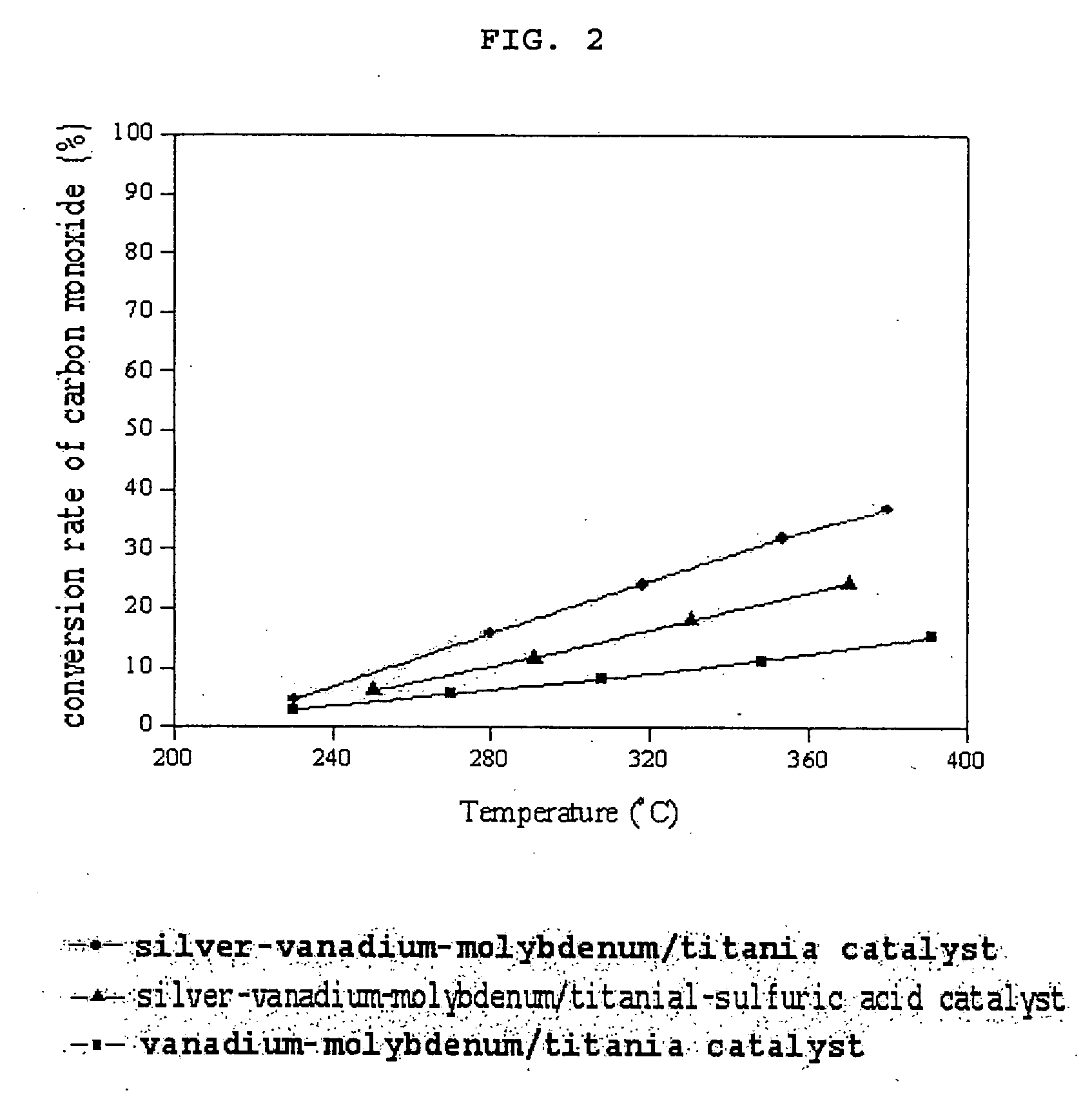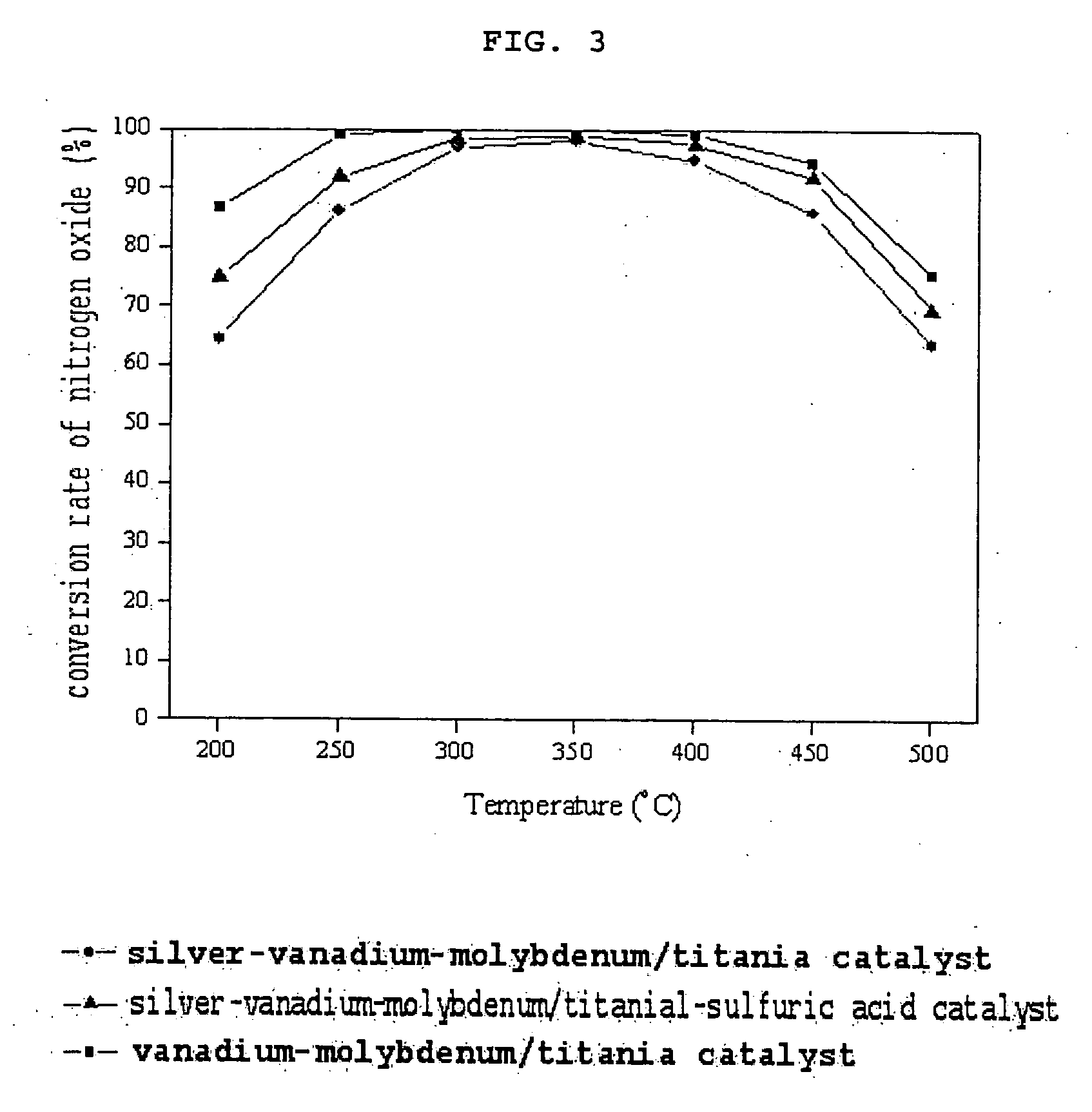Catalyst for removing aromatic halogenated compounds comprising dioxin, carbon monoxide, and nitrogen oxide and use thereof
a technology of aromatic halogenated compounds and catalysts, which is applied in the direction of physical/chemical process catalysts, metal/metal-oxide/metal-hydroxide catalysts, and separation processes, etc., can solve the problems of high treatment costs, inability to regenerate and/or dispose of activated carbon adsorbed with dioxin, and inability to complete combustion. achieve the effect of maintaining the removal efficiency of aromatic halogenated compounds and low pri
- Summary
- Abstract
- Description
- Claims
- Application Information
AI Technical Summary
Benefits of technology
Problems solved by technology
Method used
Image
Examples
example 1
[0050] Preparation of Vanadium-Molybdenum / Titania Catalyst [V—Mo / TiO2]
[0051] In deionized water, oxalic acid (C2H2O4.2H2O, manufactured by DUKSAN PURE CHEMICALS CO., LTD., KOREA) was introduced and, after stirring the solution, ammonium metavanadate (NH4VO3, manufactured by Samchun Pure Chemical Co. Ltd., KOREA) and ammonium molybdate ((NH4)Mo7O24.4H2O, manufactured by DUKSAN PURE CHEMICALS CO., LTD., KOREA) together were charged in the solution then dissolved by strongly agitating it. As an aqueous pre-catalyst solution, such solution was gradually added with titania DT51 (available from Millennium, FRANCE; with a specified crystal structure—anatase 100%, specific surface area: 80 to 100 m2 / g, SO3 content: 1 to 2% by weight) followed by strong agitation to produce a homogeneous slurry. Herein, the materials such as titania, ammonium metavanadate, ammonium molybdate had been added in a weight ratio of 25.93:1:2.55 in order to produce the slurry. The prepared slurry was coated onto s...
example 2
[0052] Preparation of Silver-Vanadium-Molybdenum / Titania Catalyst [Ag—V—Mo / TiO2]
[0053] The catalyst produced in Example 1 was impregnated in silver nitrate (AgNO3, produced by Han-Gyeul Gold Co., KOREA) then naturally dried overnight. Subsequently, by drying the catalyst at 120° C. for 4 hours then raising the temperature up to 500° C. by 10° C. per minute and calcinating the catalyst at the same temperature for 2 hours, the purposed silver-vanadium-molybdenum / titania catalyst was obtained. The produced catalyst comprised 0.84% by weight of vanadium and 5.33% by weight of molybdenum and 2% by weight of silver based on titania.
example 3
[0054] Preparation of Silver-Vanadium-Molybdenum / Titania-Sulfuric Acid Catalyst [(Ag—V—Mo / TiO2—SO42−]
[0055] The catalyst produced in Example 2 was impregnated in 0.21M aqueous sulfuric acid solution (H2SO4.xSO3, produced by Aldrich, USA) then naturally dried overnight. Subsequently, by drying the catalyst at 120° C. for 4 hours then raising the temperature up to 500° C. by 10° C. per minute and calcinating the catalyst, the purposed silver-vanadium-molybdenum / titania-sulfuric acid catalyst was obtained. The produced catalyst comprised 0.84% by weight of vanadium and 5.33% by weight of molybdenum, 2% by weight of silver and 2% by weight of sulfate based on titania.
PUM
| Property | Measurement | Unit |
|---|---|---|
| Temperature | aaaaa | aaaaa |
| Temperature | aaaaa | aaaaa |
| Time | aaaaa | aaaaa |
Abstract
Description
Claims
Application Information
 Login to View More
Login to View More - R&D
- Intellectual Property
- Life Sciences
- Materials
- Tech Scout
- Unparalleled Data Quality
- Higher Quality Content
- 60% Fewer Hallucinations
Browse by: Latest US Patents, China's latest patents, Technical Efficacy Thesaurus, Application Domain, Technology Topic, Popular Technical Reports.
© 2025 PatSnap. All rights reserved.Legal|Privacy policy|Modern Slavery Act Transparency Statement|Sitemap|About US| Contact US: help@patsnap.com



